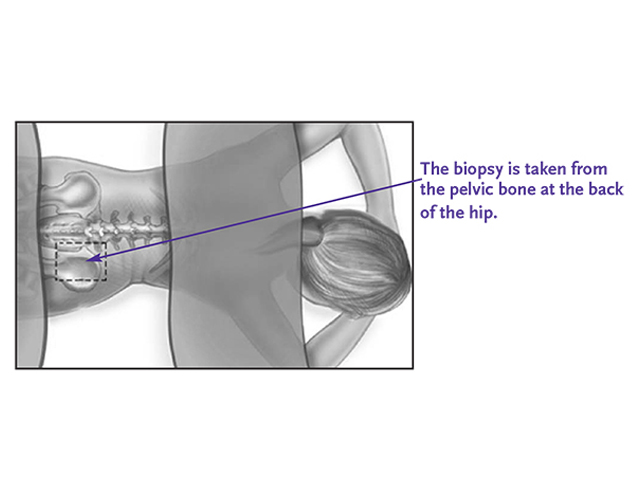Learn About Bone Marrow Transplant
Bone Marrow Transplant Program
Our Bone Marrow Transplant program is committed to developing leading-edge strategies for autologous and allogeneic bone marrow and peripheral blood stem cell transplantation.
What is Bone Marrow?
Bone marrow — the soft, spongy tissue inside the large bones in the body — can be affected by a variety of blood disorders, blood cancers and other diseases. Hematopoietic (blood) stem cells live in the bone marrow and give rise to all of the other components of the blood. Bone marrow makes red blood cells (which carry oxygen to all the tissues in the body), white blood cells (which fight infection) and platelets (which make the blood clot).
What is a Bone Marrow Transplant?
The terms bone marrow transplant and stem cell transplant are used somewhat interchangeably. For various reasons, one may receive bone marrow or blood stem cells. You may also hear this procedure called a “hematopoietic stem cell transplant.”
Bone marrow or stem cell transplants are performed for several reasons:
- To rescue and restore blood components after the patient has received high doses of chemotherapy or radiation as treatment
- To replace the patient’s blood system because their own is failing
- To replace the patient’s blood system in order to grow a new immune system which can attack the patient’s cancer
A variety of blood disorders, blood dyscrasias (diseases), blood cancers, bone marrow cancers, and other disease are potentially treated with stem cell transplants, including:
- Acute leukemia (AML, ALL)
- Adrenoleukodystrophy (ALD)
- Adult neuroblastoma
- Amyloidosis
- Aplastic anemia
- Chronic leukemia (CML, CLL)
- Congenital bone marrow failure syndromes
- Hodgkin's lymphoma (HL)
- Multiple myeloma
- Myelodysplastic syndrome (MDS)
- Myeloproliferative disorders
- Non-Hodgkin's lymphoma (NHL)
- Primary central nervous system (CNS) lymphoma
- Relapsed germ cell tumor

If you show symptoms of any of these conditions, your doctor may order blood tests to help make a diagnosis. The doctor may also conduct a bone marrow biopsy to assess for several of the conditions listed above. This test involves inserting a needle into a bone to remove a sample of the bone marrow. The sample usually comes from the back of your hip bone. By examining the bone marrow under a microscope and performing other tests, a doctor can usually identify if there is an issue in the bone marrow, and if so, plan the appropriate treatment.
Autologous vs. Allogenic Bone Marrow Transplants
There are two basic types of bone marrow transplant procedures.
Autologous:
In an autologous bone marrow transplant, patients receive their own stem cells. If no complications develop, patients will usually be in the hospital for about 2 – 3 weeks.
Your Guide to the Autologous Hematopoietic Stem Cell Transplant
Discharge Guidelines Following Autologous Stem Cell Transplant
Allogeneic:
In an allogeneic bone marrow transplant, patients receive donor stem cells. If no complications develop, patients will be in the hospital for anywhere from 1 – 5 weeks depending much on how much chemotherapy / radiation is given and what stem cell source is used. Options for source of stem cells include:
- Matched related donor transplants (usually a sibling)
- Unrelated donor transplants (identified through the National Marrow Donor Program)
- Haploidentical transplants (mismatched related donor – often a child, sibling, or parent)
- Umbilical cord blood transplants (from cord blood banks)
Your Guide to the Allogeneic Hematopoietic Stem Cell Transplant
Discharge Guidelines Following Allogenic Stem Cell Transplant
Patients go through four steps during a Bone Marrow Transplant:
- Conditioning - chemotherapy and/or radiation given the week before transplant
- Transplant – getting the infusion of bone marrow or stem cells
- Nadir – period of low blood counts
- Engraftment – when the transplanted bone marrow or stem cells start making new blood cells
After a bone marrow transplant, the donated stem cells start making new blood cells from within the bone marrow. You will have very close follow-up care with your treatment team after you are discharged from the hospital.
BMT Related Fact Sheets
- Bone Marrow Biopsy
- Understanding Your Blood Counts
- Your Guide to the Hematopoietic Stem Cell Transplant
- Your Guide to the Allogeneic Hematopoietic Stem Cell Transplant
- Your Guide to the Autologous Hematopoietic Stem Cell Transplant
- Discharge Guidelines Following Allogenic Stem Cell Transplant
- Discharge Guidelines Following Autologous Stem Cell Transplant
- Discharge Guidelines Following Allogenic Stem Cell Transplant (Arabic)
- Discharge Guidelines Following Autologous Stem Cell Transplant (Arabic)
- Discharge Guidelines Following Autologous Stem Cell Transplant (French)/ Lignes directrices à votre sortie d’hôpital suite à la greffe autologue de cellules souches
- Discharge Guidelines Following Allogeneic Stem Cell Transplant (Greek)/ Οδηγίες εξόδου μετά από μεταμόσχευση αλλογενών βλαστοκυττάρων
- Discharge Guidelines Following Autologous Stem Cell Transplant (Russian)/ Рекомендации при выписке после пересадки аутогенных стволовых клеток
- Discharge Guidelines Following Allogeneic Stem Cell Transplant (Spanish)/ Indicaciones de alta luego de un trasplante alogénico de células madre
- Discharge Guidelines Following Autologous Stem Cell Transplant (Spanish) / Indicaciones de alta luego de un trasplante autólogo de células madre
- Discharge Guidelines Following Allogeneic Stem Cell Transplant (Vietnamese) / Hướng Dẫn Xuất Viện Sau Khi Cấy Ghép Tế Bào Gốc Đồng Loại
- Discharge Guidelines Following Autologous Stem Cell Transplant (Vietnamese)/ Hướng Dẫn Xuất Viện Sau Khi Cấy Ghép Tế Bào Gốc Đồng Loại
Tour the Bone Marrow Transplant Unit on Lunder 10
Take a tour of the Bone Marrow Transplant Unit at the Mass General Brigham Cancer Institute. Learn all about the unit, including the services and amenities you and your loved ones can expect during your stay here.
Preparing for Your Visit
A checklist of items to bring with you for your first visit, and information about finding the Cancer Institute.
Supportive Care Services
Our support programs can help patients and their families cope with the challenges of a cancer diagnosis.
Contact the Mass General Brigham Cancer Institute
Contact us to make an appointment or to learn more about our programs.
